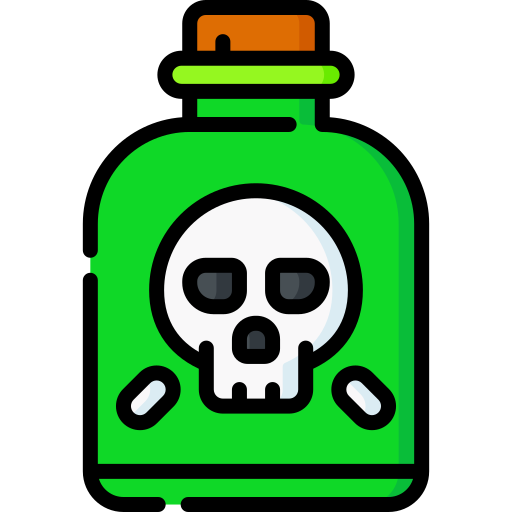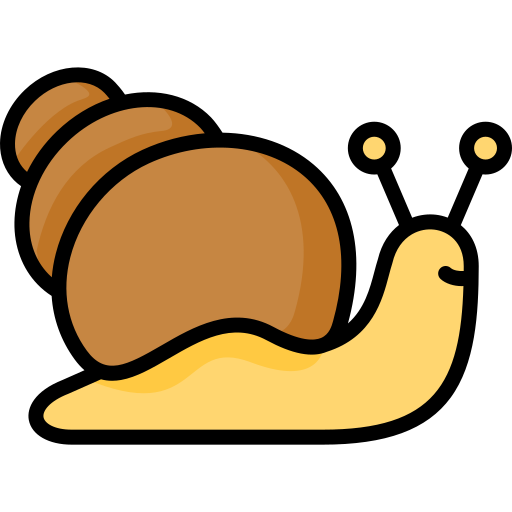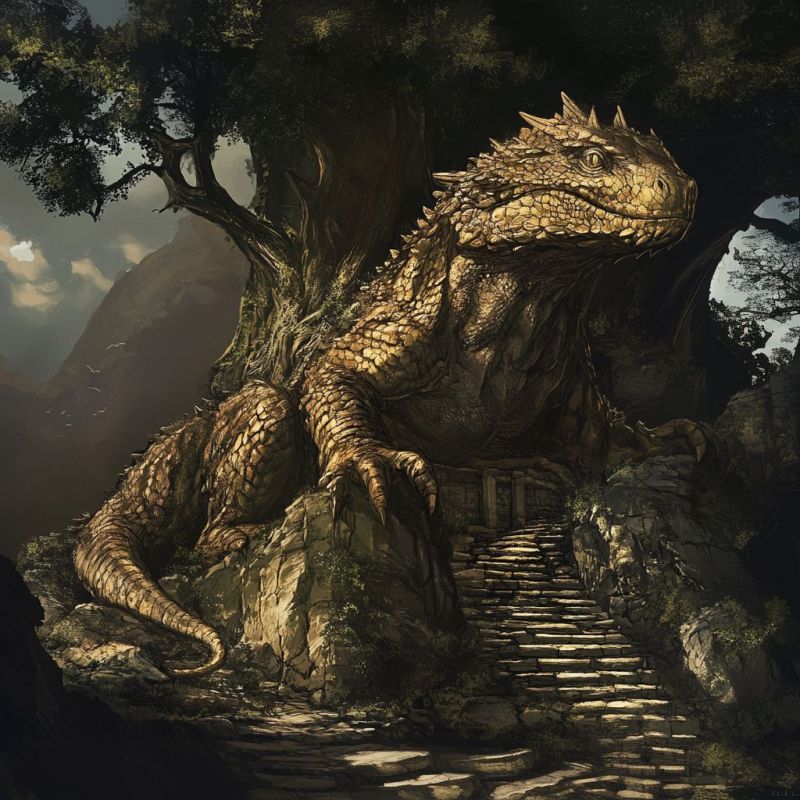 Natural Armor:
Natural Armor:-
Natural Armor +60 gp
 Natural Weapon(s):
Natural Weapon(s):-
Bite (2d10)
-
Claw (2d8)
 Abilities:
Abilities:-
Fire Breath Weapon (15) (7d6)
 Attack Abilities:
Attack Abilities:-
Fire Bite (d10)6400 gp
-
Pounce Attack150 gp
 Monster Bits:
Monster Bits:-
120 Animal Bone0.03 gp
-
225 Animal Fat0.5 gp
-
450 Animal Meat0.05 gp
-
105 Dragon Blood10 gp
-
150 Hard Skin0.1 gp
Jagged bronze scales catch the light as the drake slithers down the stone cliffside, its clawed limbs gripping each crevice with ease. A whip-like tail coils, muscles tensing, ready to strike from above.
Field Report: The Bronze Scale Drake
Logged by Minner Nibbletuff, Certified Field Scout of the Hollowheel Society of Beasts, Botanicals, and Biting Things
Location: Northspine Range, approximately 3,000 ft above mossline
Date: 19th Emberfall, Season of Ember Winds
Subject: Bronze Scale Drake (Draconis Montivagus Ferris)
Status: Active, territorial, not pleased by my presence
Introduction:
Now I’ve seen my fair share of strange mountain nasties—goat-headed manticores, stone lickers, even a yeti with a gambling addiction—but nothing puts the hairs on your toes up like a Bronze Scale Drake. Picture a dragon with no wings and a bad attitude, and you’re halfway there. The other half? Molten breath and claws sharp enough to climb a cathedral bell tower sideways.
Origins & Behavior:
Local dwarf scholars argue this creature split from the main dragon bloodline ages ago, probably out of stubbornness or bad luck. Some myths claim they were once proper dragons who had their wings ripped off for some ancient insult. Me? I think they just evolved different—climbers, crawlers, and canyon creepers.
Drakes like these aren’t just brutes. They’re calculating, territorial, and surprisingly patient. They’ll stalk wyvern roosts for days before making a move. You ever see a drake dig its claws into a vertical cliff face and slither up like some metal-scaled salamander? Gives me the shivers just thinking of it.
Feeding Habits:
Bronze Scale Drakes have a very particular craving: Wyvern Eggs. They’ll risk life and claw for them, and often do. Their hides are thick as dwarven plate and seared dark like old bronze kettles—resistant to wyvern talons and, apparently, to my crossbow bolts as well. I've seen them take on a whole clutch of wyverns, blast a gout of fire up the slope, and send the survivors squawking off to find safer cliffs.
If they win? They don't just eat the eggs—they take the nest, too. And if they lose? They retreat and hole up fast. That fire breath of theirs isn’t just for show—they melt holes into mountain rock, sealing themselves inside to heal. One I tracked created a den that smoked for three days before I dared peek in. (Note: bad idea.)
Social Dynamics:
Solitary beasts, mostly. Territorial. You’re more likely to find one ousting a troll clan than making friends. Sometimes they’ll muscle into goblin warrens, and if the goblins are smart, they flee. If not… well, let's just say I found a lot of soot and bones in one tunnel.
Field Notes & Warnings:
- Their scales shimmer like aged bronze, often caked in soot near the belly.
- Fire breath not constant—seems to need rest between gouts, possibly heat-storing organ?
- Excellent climbers. DO NOT assume verticality = safety.
- Tail is whip-like, used to knock prey off cliffs. I lost a pack mule that way.
- Not fans of noise. Bell chimes or high-pitched sounds seem to agitate them. Maybe territorial reaction?
Conclusion:
The Bronze Scale Drake isn’t just a scaled menace. It’s a survivor, a strategist, and a terrifying testament to what happens when evolution favors fire and fangs over wings and wind. If you’re planning to hunt one (gods help you), don’t bring air cover—bring rope, heat resistance, and a very good escape plan.
Also, if you find one sleeping, leave it be. I thought I found a dead one once. It was just napping. I still limp.
Signed in coal-ink with my left hand (the right’s still scorched),
Minner Nibbletuff
Hollowheel Society of Beasts, Botanicals, and Biting Things
🐉💪 Drakes: Landbound Lords of Fury
Drakes are the earth-shaking kin of dragons, wingless but no less fearsome, their muscled forms carving dominion over Zin’s wilds. 🦎 Clad in scales of bronze, emerald, or obsidian, these apex predators roam with primal might, their roars trembling the ground and their elemental breath scorching all in their path. Lacking the skyward grace of true dragons, drakes are relentless hunters, their raw power and territorial instincts making them a terror to any who trespass.
🔥 Origins: Born of Dragon’s Blood
Drakes are primal offshoots of dragonkind, their origins tied to ancient draconic bloodlines diluted by the wilds of Zin. 🌋 Some legends claim they were forged by earth-bound deities or birthed from dragon eggs touched by primal magic, stripping them of wings but amplifying their terrestrial might. Their ferocity echoes their draconic heritage, a legacy of instinct over intellect. Game Masters can weave drakes into campaigns as remnants of a lost dragon age or guardians of primal relics buried in the earth.
🦴 Physical Characteristics: Scaled Behemoths
Drakes are built for ground-based dominance, their four powerful limbs rippling with muscle beneath gleaming scales. 🛡️ Their claws rend stone, their fangs pierce steel, and their whip-like tails shatter bone with a single lash. Some drakes climb cliffs with hooked talons, others swim through rivers like scaled serpents, their adaptability rivaling their strength. GMs can emphasize their imposing presence, describing the ground quaking under their charge or their scales glinting like molten metal in the sun.
⚡️ Fire and Fury: Elemental Wrath
A drake’s breath weapon is a devastating echo of its draconic kin, unleashing torrents of fire that melt stone, searing winds that flay flesh, or toxic fumes that choke the air. 🌪️ Their bone-rattling roars sow panic, cowing lesser beasts and unnerving even seasoned warriors. In combat, drakes are relentless, combining elemental assaults with brutal melee. GMs can heighten encounters with vivid descriptions of a drake’s breath igniting forests or its roar echoing through canyons, creating moments of primal terror.
🏞️ Territorial Nature: Roaming Conquerors
Unlike dragons with their hoarded lairs, drakes are nomadic, claiming temporary strongholds in caves, ruins, or tangled forests. 🌲 They seize territories from weaker creatures like wyverns, sparking savage battles that scar the land. These domains are less about treasure and more about dominance, marked by claw-gouged stone or scorched earth. GMs can craft drake territories as chaotic battlegrounds, with players navigating the aftermath of a drake-wyvern clash or hunting a drake to claim its lair.
🐲 Drake vs. Dragon: Instinct Over Ambition
While dragons hoard wealth and scheme with cunning, drakes are driven by survival and instinct, their pride rooted in raw power rather than greed. 🪙 Their scales, though nearly as tough as a dragon’s, are prized by craftsmen who can discern their subtle differences. Drakes lack the intellect for elaborate plans but compensate with relentless aggression, making them unpredictable foes. GMs can contrast drakes with dragons in campaigns, highlighting their primal nature as a foil to draconic arrogance.
🏰 The Drake’s Stronghold: Bastions of Instinct
A drake’s lair is a rugged fortress of nature’s design—caverns carved by their claws, ruins reclaimed by their presence, or forests scorched by their breath. 🕸️ These sites are temporary, littered with the bones of prey or shattered remnants of challengers. Natural hazards like unstable cliffs or toxic pools guard their domains, reflecting their untamed essence. GMs can design these lairs as primal dungeons, with environmental challenges that test players’ survival skills before facing the drake itself.
⚔️ Confronting the Drake: A Trial of Courage
To battle a drake is to face a juggernaut of scale and fury, its breath weapon and crushing strength overwhelming the unprepared. 🗡️ Heroes must use mobility to evade its charges, targeting vulnerabilities like eyes or underbellies with magic or heavy weapons. Terrain can be an ally—luring a drake into tight spaces or water to dull its breath. GMs can craft encounters as desperate hunts, with players ambushing a resting drake or surviving its territorial wrath.
🌌 Apex of Terrestrial Might
Drakes are the unchained fury of dragonkind, their wingless forms no less regal in their dominance of Zin’s wilds. 🐍 As relentless predators, they carve their legend through strength and instinct, their roars a challenge to all who dare approach. Whether seizing lairs or clashing with rivals, drakes embody the raw pulse of the earth. Only the boldest adventurers can face their elemental rage and emerge victorious, claiming glory over these landbound titans. 💥
 Damage Type Resistances(s):
Damage Type Resistances(s):-
 Poison
Poison
 Immune to Status Effect:
Immune to Status Effect:-
 Hamstrung
Hamstrung -
 Immobile
Immobile -
 Stunned
Stunned
